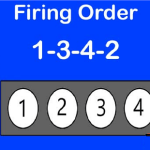Diesel engines
Timing methods vary widely in different engine designs, but all must be set exactly as even a small timing error can stop the engine or seriously damage it. Injection, and the opening and closing of the valves, is accurately timed in relation to the position of the piston, by the gear or chain drive from the crankshaft to the camshaft. The meshed teeth of the gears ensure that injection and valve operations occur at the correct point of each work cycle. At speed engines work cycles occur so rapidly that valve and injection has to be initiated prematurely to counter the miniscule delay in actuating mechanism.
Four stroke engines have twice as many teeth on the camshaft gear (or sprocket) as there are on the crankshaft gear. This means the camshaft runs at half the speed of the crankshaft. The camshaft turns (injection and valves operate) only once for every two revolutions of the crankshaft.
With two stroke engines, injection occurs and the valves will open and close on each turn of the crankshaft. In two-stroke engines, the camshaft must run at the same speed as the crankshaft.
The specific opening and closing of the inlet and exhaust valves and the period of injection of the fuel can be taken from the engine manufacturers timing diagram. Examples are shown below:
Four stroke cycle diesel engine
The diagram below represents a Caterpillar turbo charged after cooled engine. The induction stroke commences when the inlet valve opens 10° before tdc when air is drawn into the cylinder as the piston moves down. The inlet valve closes 1° before bdc. The air is now trapped in the cylinder and as the piston rises on the compression stroke, the air is compressed. As the air is compressed, it rises in temperature. When the piston reaches 19° before tdc, the injection of fuel commences and continues until 73° after tdc.

The heat in the compressed air ignites the fuel and combustion takes place. The gases expand forcing the piston down on the power stroke. The exhaust valves opens at 26° before bdc and the exhaust gases are discharged as the piston rises on the exhaust stroke. Most of the exhaust gases have been discharged as the piston nears tdc. However, at 10° before tdc, the inlet valve opens and air enters the cylinder and helps discharge any remaining exhaust gases until the exhaust valve closes at 3° after tdc. The whole cycle is then repeated.
Both the exhaust valve and inlet valve are open from 10° before tdc to 3° after tdc, an overlap of 13°. This is referred to as “valve overlap” and ensures that all the exhaust gases are discharged from the cylinder and the cylinder receives a fresh charge of air to make it more efficient when combustion next takes place. Therefore there is one power stroke for every cycle or two revolutions of the crankshaft.
Two stroke cycle diesel engine
The two strokes of power followed by compression are required to complete one cycle. The events of injection, combustion, expansion and compression of the gases takes place as the four stroke engine, but the exhaust of the burnt gases and the induction of air take place at the bottom of its stroke, this being a chief difference between the two stroke cycle and the four stroke cycle.
There are variations in two stroke cycle engines. The type described here is the most common to be found in marine engines. It has inlet ports and exhaust valves. The inlet holes or ports are in the lower section of the cylinder liner wall. The piston uncovers the inlet ports as it moves down the cylinder. The piston covers the inlet ports as it moves up the cylinder. This action has the same effect as a valve opening and closing. An engine driven scavenge blower is fitted and the incoming air is blown into the cylinder through the inlet ports when they are uncovered by the piston.

The above timing diagram represents a Detroit Diesel turbo charged inter cooled engine. Induction commences at 49° before bdc when the piston has uncovered the inlet ports. Air is forced into the cylinder by the scavenge blower as the piston moves down to bdc and back up again until it covers the inlet ports at 49° after bdc.
As the piston rises, the exhaust valve closes at 62° after bdc. The air is now trapped in the cylinder and as the piston rises the air is compressed and rises in temperature. Fuel is injected before tdc and continues after tdc. Detroit Diesel do not specify the period of injection as this will vary depending upon the engine speed, the load and the size of the injectors. The camshaft contains the exhaust valve cams as well as the unit injector cams. Therefore, if the exhaust valve timing is correct, the unit injector timing will be correct providing the injector follower is adjusted to a definite height in relation to the unit injector. A special gauge is supplied to set this height. The heat in the compressed air ignites the fuel and combustion takes place. The gases expand forcing the piston down on the power stroke.
The exhaust valve opens at 83° before bdc allowing the burned gases to escape into the exhaust manifold. However, at 49° before bdc, the inlet ports are uncovered by the piston and air enters the cylinder and helps discharge any remaining exhaust gases until the exhaust valve closes at 62° after bdc. The whole cycle is then repeated.
There is one power stroke for every revolution of the crankshaft.


